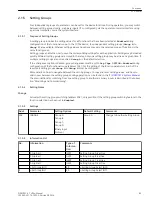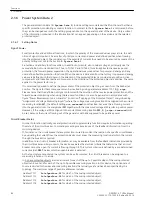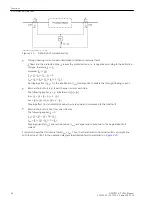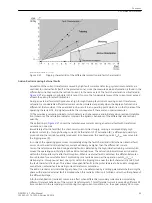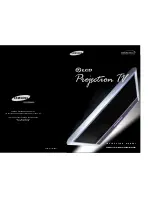
Power System Data 2
The general protection data (
P.System Data 2
) include settings associated with all functions rather than a
specific protection, monitoring or control function. In contrast to the
P.System Data 1
as discussed before,
they can be changed over with the setting groups and set on the operator panel of the device. Only a subset
of the information contained in the information list can appear, depending on the version and the selected
protected object.
Setting Notes
Sign of Power
For all protective and additional functions, in which the polarity of the measured values plays a role, the defi-
nition of signs is important. As a matter of principle, currents and power are defined positive when flowing
into the protected object. The consistency of the polarity of currents thus needs to be ensured by means of the
polarity settings set out in the Section
P.System Data 1
.
Protection and ancillary functions which, in addition to currents, also consider voltages, principally use the
same definition of current direction. Thus, in 7UT613 and 7UT633, this also applies to the reverse power
protection, the forward power supervision, the operational measured values for power and energy and any
user-defined flexible protection functions. When the device is delivered from the factory, its power and energy
values are defined such that power in the direction of the protected object is considered as positive: Active
components and inductive reactive components in the direction of the protected object are positive. The same
applies to the power factor cos φ.
It is occasionally desired to define the power draw of the protected object (e.g. as seen from the busbar) as
positive. The signs for these components can be inverted by using parameter address 1107
P,Q sign
.
Please ensure that the definition of signs conforms with the direction of the reverse power protection and the
forward power monitoring when using these power functions. In case of a generator in accordance with
figure “Power Measurement on a Generator” (in section “Topology of the Protected Object”, margin heading
“Assignment of Voltage Measuring Inputs”) where the voltage measuring location U is assigned to the current
measuring location M1, the default setting
not reversed
is not inverted, because the in-flowing current
into the generator from the starpoint at M1 together with the measured voltage at U results in positive power.
However, if the voltage at U is assigned to the current measuring location M2,
P,Q sign
=
reversed
must
be set, because the current flowing out of the generator with U is supposed to be positive power.
Circuit Breaker Status
In order to function optimally, several protection and supplementary functions require information regarding
the state of the circuit breaker. Command processing makes also use of the feedback information from the
switching devices.
If, for instance, the circuit breaker failure protection is used to monitor the reaction of a specific circuit breaker
by evaluating the current flow, the protection device must know the measuring location at which the current
through the breaker is acquired.
In addition to such circuit breaker information, as may be available from the feedback indications provided by
the circuit breaker auxiliary contacts, the device evaluates the electrical criteria that determine that a circuit
breaker cannot be open if a current is flowing through it. This current criterion is defined by a pre-determined
current value I-REST, below which an open breaker is detected.
As the topologies encountered in a system can be quite complex, the circuit breaker can be assigned to a
measuring location or to a side.
In 3-phase protected objects a residual current for each of the up to 5 possible sides of the main protected
object can be set and for each of the up to 5 possible measuring locations. In this device, the options are of
course restricted to the sides and measuring locations that actually exist and have been specified by the
topology. The maximum range of possible addresses includes:
Address 1111
PoleOpenCurr.S1
for side 1 of the main protected object,
Address 1112
PoleOpenCurr.S2
for side 2 of the main protected object,
Address 1113
PoleOpenCurr.S3
for side 3 of the main protected object,
Address 1114
PoleOpenCurr.S4
for side 4 of the main protected object,
2.1.6
2.1.6.1
Functions
2.1 General
86
SIPROTEC 4, 7UT6x, Manual
C53000-G1176-C230-5, Edition 09.2016
Summary of Contents for SIPROTEC 4 7UT6 Series
Page 394: ...394 SIPROTEC 4 7UT6x Manual C53000 G1176 C230 5 Edition 09 2016 ...
Page 482: ...482 SIPROTEC 4 7UT6x Manual C53000 G1176 C230 5 Edition 09 2016 ...
Page 504: ...504 SIPROTEC 4 7UT6x Manual C53000 G1176 C230 5 Edition 09 2016 ...
Page 522: ...522 SIPROTEC 4 7UT6x Manual C53000 G1176 C230 5 Edition 09 2016 ...
Page 528: ...528 SIPROTEC 4 7UT6x Manual C53000 G1176 C230 5 Edition 09 2016 ...
Page 538: ...538 SIPROTEC 4 7UT6x Manual C53000 G1176 C230 5 Edition 09 2016 ...
Page 664: ...664 SIPROTEC 4 7UT6x Manual C53000 G1176 C230 5 Edition 09 2016 ...
Page 666: ...666 SIPROTEC 4 7UT6x Manual C53000 G1176 C230 5 Edition 09 2016 ...
Page 684: ...684 SIPROTEC 4 7UT6x Manual C53000 G1176 C230 5 Edition 09 2016 ...














